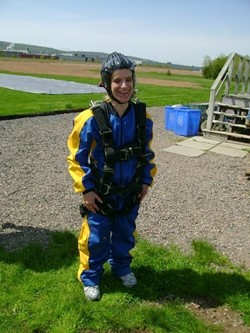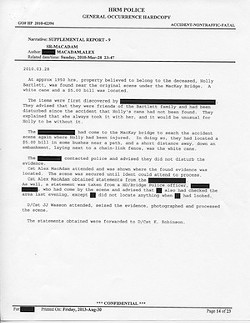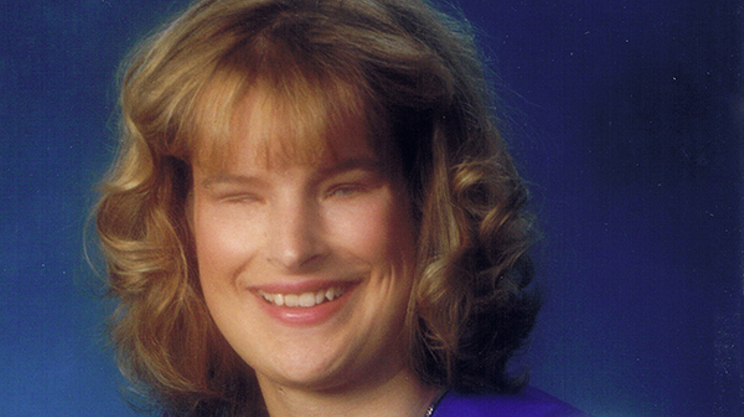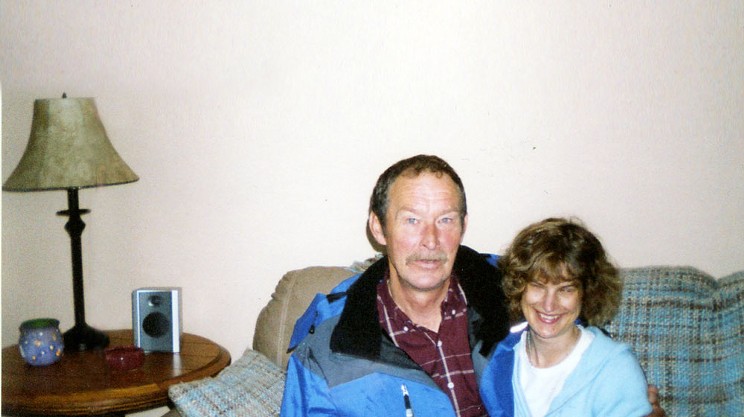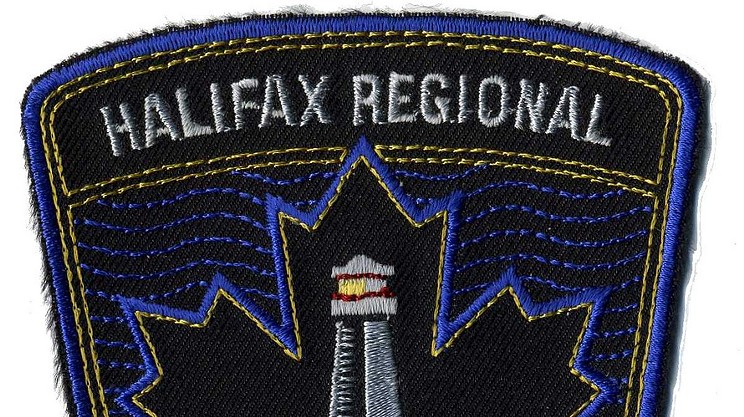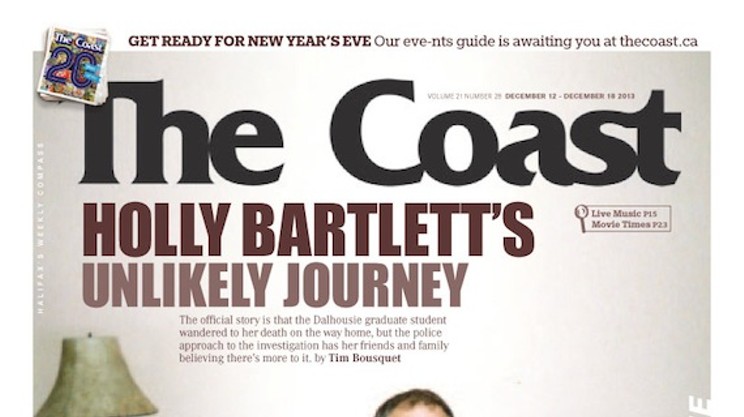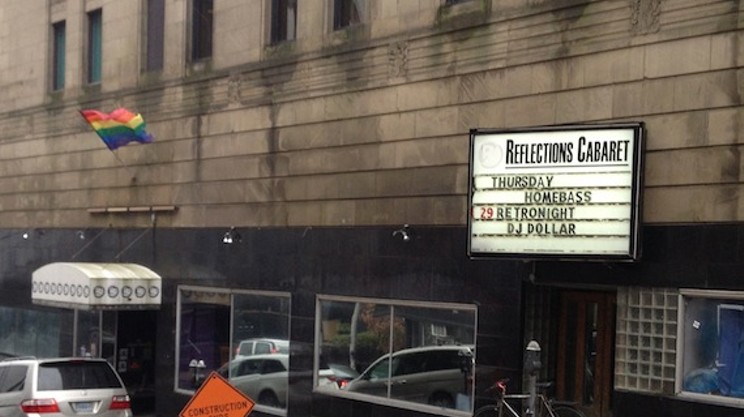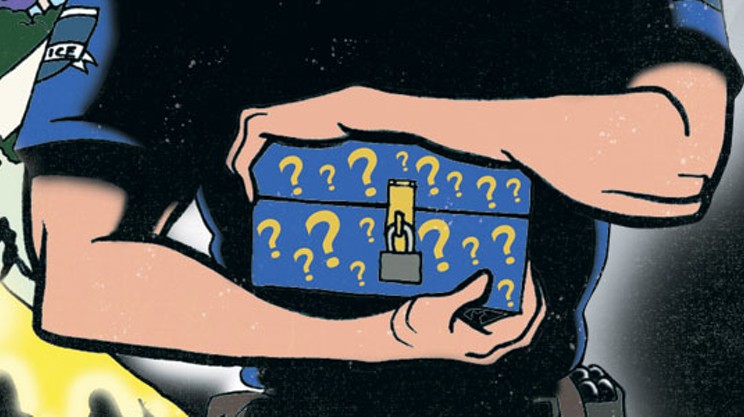Update, February 24, 2014: Halifax Regional Police and Halifax District RCMP have announced an independent review of the police investigation into Holly Bartlett's death. For more information, click here.
Work finished early that Friday afternoon, but Holly Bartlett's day was just getting started. She had to shop for a birthday present for her six-year-old nephew—Holly settled on a Wii controller—before going to a class at Dalhousie. After class came the bus ride home, to the northern edge of the peninsula, to her condo a block from the MacKay Bridge. She had to get ready for a night out.
She dressed in bold colours: blue jeans, knee-high black boots, a sequined royal blue blouse. She applied lip gloss. If she ran a brush through her brown hair no one would know. It was hopelessly mopish, unruly hair—matching her energetic lifestyle—so she kept it short, just over the ears. Heading for the door, she donned a red wool coat with a stand-up collar, and black leather gloves. She grabbed her purse, a small black pouch she wore like a backpack.
A few weeks before, Holly had started a job as a researcher for the province. She was also nearing the end of her grad program at Dal, and the coursework was intense. At the same time her father, who she adored, was dying of lung cancer. Every night that week she had gone to her parents' house to sit with him, to be by his side, hold his hand and just talk.
But tonight, Holly needed a break. Some time to wind down, to hang with her friends. "I'll be back Saturday," she told her father.
Back downtown, she met her friend Moira for dinner at The Fireside Restaurant. After a quick meal and a drink, the pair stopped by a liquor store to buy a bottle for a small get-together at a mutual friend's house. After an hour or so, the group headed off to the department of public administration's year-end party at the University Club.
"There were 30 or 40 people," recalls Holly's friend and classmate Gabryel Joseph. "There was an open bar and gag prizes. Our program was incredibly demanding, and we had to unwind."
Holly had a few drinks, but "if anyone is suggesting she was too drunk, I can assure you that was not the case," says Joseph. "She was laughing, having a good time, not slurring her words." At 11pm, Holly was ready to go home. A friend called a cab for her, but when the cab arrived the department proceedings were still going on, and Holly wanted to hear the last speaker. The cab was waved off.
After the last speech, another friend called a second cab. It arrived at 11:50pm, and the friend walked out to the waiting cab with Holly, making sure she was safe.
But Holly never made it home.
Saturday morning dawned cold—six degrees below freezing, a wind chill of minus 10—but Stuart Herlt and his crew had a schedule to keep, so they were off to the job site just as the sun rose. Herlt works for Cherubini Metal Works, which had been hired to install two towers beneath the MacKay Bridge, near where the two giant cables that hold up the suspension bridge make landfall on the Halifax side.
The cables are anchored by what's called an abutment, a massive concrete wedge that slopes steeply up from the ground to a point nearly 10 metres high. The wedge, about as big around as a tennis court, is surrounded by a wide margin of land, more than the size of a football field. A chain-link fence two metres high borders the whole field, although its protective value is dubious—graffiti was scrawled over the abutment this Saturday morning. For sanctioned access, there is a padlocked gate in the fence.
The towers Herlt and his team were installing stretched from the land beside the wedge to the bridge itself, so the group split up, with Herlt and a couple other workers heading to the bridge deck. The ground crew went to the fence, where they met a bridge commissionaire.
"The commissionaire opened the gate and two of our guys went in," says Herlt. "The first guy saw something laying there. He couldn't make out what it was, and so they went over and they noticed it was a person. They thought she was dead, but then they noticed she was trying to breathe. They noticed she was really cold, so they put one of their coats—their ironworker coats—on her. And they ran back to get the commissionaire, and they got him to call 911. At that point, I was on the catwalk and looked down, and I saw the ironworker coat just laying there, and someone lying there. I kind of freaked out; I thought one of the ironworkers had fallen from up top."
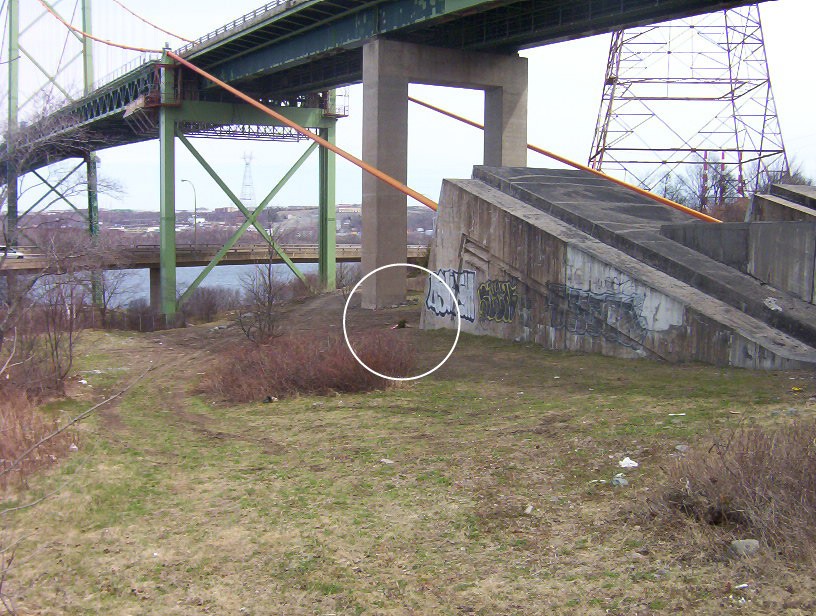
It was Holly. An ambulance soon arrived, and the EMTs who examined Holly found severe bruises on her face, cuts on her hands and knees. Her leg and some ribs were broken, her body temperature was 23 degrees and she had a blood alcohol content of 0.09 percent. The ambulance got her to the hospital at 7am, and she went into surgery at 8:04. Her condition was touch-and-go through the day, but overnight she declined. Sunday morning, two attending doctors agreed that "further support in this lady was futile and only served to prolong her death."
With her family at her bedside, Holly's life support system was turned off. She died at 10:45am, Sunday, March 28, 2010.
Even as Holly lay dying in the hospital, police were working to solve the mystery of how a capable 31-year-old could come to such harm 300 metres from her home. But just as quickly, the police started losing the trust of Holly's family. Now, nearly four years later, people who knew Holly are frustrated and angry at the lack of answers, while the police department remains indifferent to new facts that could explain things, and to her family's suffering.
Police constables Matthew Luck and Jason Marriot arrived beneath the bridge at 6:47am, while the EMTs were working on Holly. Marriot "noted a black baseball hat just to the south of where Bartlett's body was laying," he wrote in his report. "The hat had a Harley Davidson logo on the side of it."
Holly was wearing her red coat. Her purse was lying on the ground near her head. It contained an expired school ID, a bus pass, a Tim Hortons card, gloves, sunglasses, lip gloss and her ID card from the Canadian National Institute for the Blind.
For the rest of Saturday, the integrated Halifax Regional Police/RCMP General Investigation Section reconstructed Holly's movements from the day before, pulling her bank records, watching video from the liquor store and interviewing those who had been with her. The police confirmed with Holly's family that she was blind. At the hospital, Holly was checked for signs of rape, and there were none. Police interviewed the cab driver, who said he'd dropped Holly off in front of her condo building around midnight.
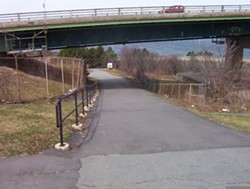
Holly lived in a distinctive part of Halifax, where the MacKay Bridge is an unavoidable part of the landscape. Novalea Drive runs straight north for nearly two kilometres through residential neighbourhoods before it abruptly swings left, becoming North Ridge Road, parallel to the bridge jutting out over the harbour. Holly's building, Convoy Towers, is less than 300 metres from Novalea—reached by a left off North Ridge, up through a sloped parking lot and to the circular driveway in front of the building.
Although vehicles have to make the left turn from Novalea to North Ridge in order to avoid the bridge, pedestrians can go straight at the intersection, walking on an asphalt footpath that leads under the bridge to Seaview Lookoff Park. Beside the footpath on the right is the fence around the cable abutment site where Holly was found.
The first thought when someone is found severely injured under a bridge is a suicide attempt. But police quickly ruled this out, as no motorist reported a pedestrian on the bridge Friday night, and bridge surveillance cameras didn't show Holly. Moreover, if she wanted to jump to her death, she could have used her own eighth-storey balcony at home.
So what happened to Holly? Based on the first day's investigations, sergeant Mark McKinley, supervisor of the Investigation Section, came up with a theory that he typed into the police file Saturday night.
McKinley noted that the cab driver said he remembered Holly and that he could tell she was drunk in the back seat. When he pulled up to Convoy Towers, the building was on the passenger side of the car, although after she paid the fare Holly got out of the cab on the driver's side. The driver says he didn't realize she was blind, so didn't think anything of it, but getting out of the car on the driver's side meant as the cab drove off, Holly was walking away from her building.
McKinley theorized that Holly was disoriented, and in this state he pictured her wandering from the wrong side of the cab, across the driveway and down the sloped parking lot. At North Ridge Road she must have turned toward Novalea, then walked almost 200 metres to reach the footpath under the bridge. Starting down the path, she either tripped or stumbled, landing next to the fence around the abutment site.
The police used a search dog when they were exploring the area during the day Saturday, and at one point the dog went through a small hole in the fence. The hole wasn't much bigger than the dog, but it took on a large significance for McKinley. He figured Holly fell beside the hole, and when she got moving again she must have crawled through. Then she crossed the field to reach the abutment. In his mind, the concrete slope of the wedge felt to Holly like the inclined footpath she'd fallen from, so naturally she climbed onto it. Holly then went up the wedge on her hands and knees, until she got to the top and went over the edge, falling two-and-a-half storeys to the ground.
To McKinley, the journey from the condo's driveway, across the parking lot, along the road by the bridge, down the path, through the fence and up the concrete wedge was a plausible misadventure for a disoriented blind person. There were only a couple of minor tasks to follow up on. The investigation, he wrote in the report, would be complete "next week."
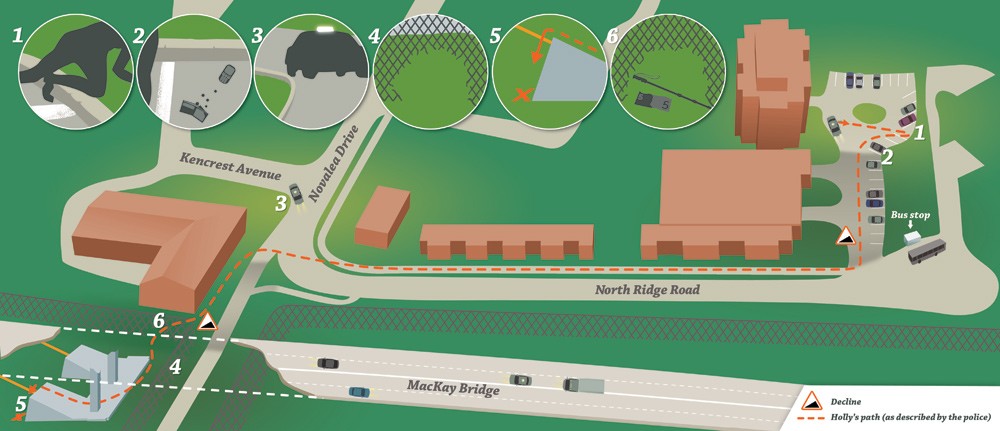
Wayne and Marion Bartlett had three children. The oldest is Kim, a medical researcher in the United States. The youngest is Amanda, an executive assistant with Jazz Air in Halifax. The middle daughter, Holly Elizabeth Bartlett, was born December 26, 1978 in Halifax.
"She was only hours old when they came and told us that there's something wrong with her eyes," says Marion.
Holly was diagnosed with microphthalmia, under-developed eyes, coupled with astigma, a difficulty in focusing. Through her childhood, Holly could still see with difficulty, but her sight deteriorated as she grew. She was also unusually small—4'11" and less than 100 pounds as an adult—and the target of bullying.
Holly would look back at this difficult period with humour. "When I lost my vision at the age of 13, that was a rather traumatic experience, but everything at 13 is traumatic," says Holly, laughing, in a video called Sights Unseen. King's College student Kim Hart Macneil made the video for a class project in 2009.
"So, at 13 or 14," continues Holly in Sights Unseen, "it was like, I can struggle with social stuff, or I can study and be smart. I chose to study and be smart."
From the time she entered school, Holly was helped by the Atlantic Provinces Special Education Authority, which provides services to children who are visually or hearing impaired. For grade nine, she attended the APSEA-run Sir Fredrick Fraser school for the blind and she learned "O&M" skills—orientation and mobility, how to get around as a blind person.
Holly attended Prince Andrew High School in Dartmouth, then became the first blind student who'd ever gone to Saint Francis Xavier University in Antigonish. She graduated in 2002, earning a BA in psychology, then moved to Ottawa, where she found work with the federal government. She also found a boyfriend, and moved in with him.
In 2005, when her boyfriend landed a job in Halifax, Holly decided it was time to move back to town. The pair got an apartment, and she started attending classes at NSCC to get a certificate in Human Resources.
"That's when I met her," says Peter Parsons, who was then an O&M specialist with the Canadian National Institute for the Blind. "She called me to brush up on her cane skills, because they were rusty. Then I'd watch her with perfect cane skills and crossing the street so straight, and I was, 'OK, you call that rusty.'"
Holly called Peter every time she had a new route to learn. "With Holly, you show her once, she was such a quick learner and for being totally blind," says Peter. "She pretty much had it after showing her one time."
Like many people in their 20s, Holly bounced around a lot before she found a life that worked for her. She broke up with her boyfriend, moved in with a friend for a few months, then got an apartment of her own. Another year passed, and Holly and her old high school buddy Andrew Seely decided to buy a condo together in Convoy Towers, on the top floor.
"We called it the penthouse," says Seely. "I remember the first time we saw it, and I told Holly I really liked how spacious it was. 'And the view is wonderful!' she joked."
Since moving back to Halifax, Holly couldn't get a full-time job and, tired of part-time and contract work, she decided to go back to school. To improve her presentation skills as part of her masters program, Holly joined Toastmasters, the organization that helps people with public speaking. That's where she met Kirk Furlotte.
"I had gone sky diving once, and wanted to go again," says Furlotte. "We were at the meeting, and I don't think I had finished saying, 'I want to go again,' and she was, 'Can I come, too?!'"
The pair went to the the airfield in Berwick, where Holly went on a tandem jump with an instructor. "She went up, she came down," Furlotte says. "She had this huge smile on her face."
Another of her friends brought Holly to a swing dancing class. "When I started taking lessons, there were some awkward moments, because people weren't sure how to help me," says Holly in the Sights Unseen video. "And I guess the other thing is that I wasn't exactly walking around with my cane, waving it around and dancing with it, so some people didn't even know that I couldn't see, until all of a sudden I'm right in front of them."
"She loved to dance," says David Bird, another of Holly's friends. "I remember once we went to the Pogue Fado, and she danced all night."
But not everything was going well. Holly's father, Wayne, was dying, and she wasn't taking it well. She was using anti-depressants to help deal with her pain. Holly tried to sit with her dad as often as she could, but she took that Friday night as her own time. She'd get back with her dad Saturday, after a morning meeting with classmates to finish a school project.
At 8:20 Saturday morning, however, Marion received a call from the police. "It's about your daughter Holly," the officer said. "You should come to the Queen Elizabeth right away."
People who knew her have a hard time believing Holly could, as the police speculated, simply wander off disoriented and fall to her death. Her friends think the police hadn't taken the investigation seriously.
For example, what about the black Harley Davidson hat found near Holly? There's no indication that the hat was collected into evidence or examined.
Then there's the issue of the Holly's purse. While some of the contents were found Saturday morning in the purse, near her body, other items—her wallet, iPhone, lip gloss and loose change—were found Saturday morning at 7am, in the parking lot outside Convoy Towers, by a security guard returning home from working the night shift. The phone and other items were found between two cars, across the lot from where the cab driver said he had left Holly off. The security guard would later tell a private investigator that the items were spread across the lot, "as if they had been thrown from a passing car."
And where was Holly's cane? The Saturday Holly was found, police had secured the scene for over five hours, with at least four officers investigating. Constable Paul Jessen brought the search dog, named K93D, specifically to look for the cane. Jessen and K93D looked around the parking lot of Convoy Towers, then they walked along North Ridge to the footpath that goes under the bridge. There, they found the hole in the fence that McKinley's theory would rely on, but no cane. Then they checked around an apartment building at the corner of Novalea and another side street, Kencrest Avenue, that is next to the bridge and the cable abutment fence. Still no cane.
The next day, however, a few of Holly's friends went to the site. They were determined to walk all the way around the abutment fence, not just concentrating on the western edge, parallel to the footpath, where K93D found the hole. Sure enough, on the southern edge, perpendicular to the footpath, they found the cane. It was leaning against the fence, at the bottom of a slope leading up to the Kencrest apartment building. A few feet away they found a $5 bill, presumably also Holly's. The cane was about 20 metres away from the footpath. Near the cane was a second hole in the fence, which the police had not reported the day before.
That a group of civilians could so readily find the cane on Sunday, after the investigating officers and search dog had found nothing Saturday, is odd. If the cane was there all along, then the police search wasn't as thorough as they claimed. But if somebody put the cane there after the police left the scene, then it should have been entered into evidence and fingerprinted, and the investigation should've been expanded to look for whoever moved it.
However, the cane was not fingerprinted. And the search was not questioned. Instead, sergeant McKinley expanded his theory about Holly's wandering to fit the cane's appearance.
Where Saturday he'd assumed Holly had simply fallen off the path and landed beside the first hole in the fence, his Sunday report theorized that Holly successfully made it down the footpath to the point where it met a secondary path. She turned and followed that secondary path all the way to a service door at the Kencrest apartment, which was presumably locked. She then made her way through the shrubbery behind the building, tumbled down the slope and wound up at the second hole in the fence. McKinley thought maybe Holly went through the fence to look for her cane. (See McKinley's revised theory here.)
Peter Parsons, the Orientation and Mobility specialist at CNIB, was out of town when he heard about Holly's death. He missed her funeral, but the day Peter arrived back in Halifax, he took his lunch hour from work and met three colleagues from APSEA at the site under the MacKay Bridge.
"I was hoping to go there, look and make sense of it," says Peter, "but instead, I went there, and it made less sense, after seeing—there's no way."
Nova Herring, another O&M specialist, was one of the four who met under the bridge. She knew Holly well, and after visiting the site she couldn't believe McKinley's theory: "If Holly had been dropped off in front of her condo, I don't know how it would be possible."
Soon after Holly had bought the condo in 2007, Herring gave Holly a ride home. "I had never been to her condo, and she gave me immaculate directions home that night," Herring says. "She explained to me how to turn into the parking lot in front of her condo, and to stay to the right hand side of the little loop that goes around. She explained to me that I could stop so that her door was directly across from the condo. She would just have to get out of the door and walk straight ahead to the condo door."
If the cab didn't stop at the right spot, the sound of traffic on the bridge would be useful information to Holly. "She would've known that if she was going to her home, travelling to her condo, that traffic would be on her right-hand side," says Herring. "If she had be walking away from her condo to where she was found, that traffic would be on her left. That really steep decline that leads from Novalea straight under the bridge, she would've known that that is not somewhere where she is supposed to be."
The shape of the concrete wedge would help Holly navigate, too. Rather than a smooth, flat expanse all the way up the slope, the wedge has walls and ridges. Assuming she fell from a spot directly above where she was found, Holly's path must have been up an edge of the cable abutment with a drop to her left and a wall of concrete to her right. "Even not knowing where she was," says Herring, "she would've been able to perceive. Holly in particular.
"When we walked down a sidewalk, we would pass a guy wire, and she would ask me, 'What is that?' It's called facial vision—the pressure changes in their ear, and they can tell that they've passed something. A bus shelter is a gimme, anyone could pick that up, but Holly could pick up a guy wire. She would not have climbed that cement abutment, with the cement wall on one side, a drop-off on the other. She would've heard the changes in that going up. She would not have thought it was that steep bank, or that steep pathway, because it had that cement wall."
Then there's the fall itself. The police theorize that Holly crawled up the cement incline, on hands and knees, one hand before the other. To have fallen off the end of the incline, she would've had to put one hand into the void, find nothing to hold, and then keep going.
Herring says even if Holly was so drunk as to be disoriented, the police theory of her long journey from the Convoy Towers parking lot to under the bridge, makes no sense. "If you ever see a blind person who is disoriented, trying to find their way...think about a dog sniffing," she says. "They kind of go around, around, around the same area. They don't travel that amount of distance. She would've wandered around in her parking lot, or wandered around that street with all of those houses lining it. And it wouldn't have been above Holly to knock on a door and ask for help."
After the meeting at the bridge, Peter Parsons went back to the office and called the police. He wanted "to express my professional opinion and concern that it didn't seem right, being an orientation and mobility specialist," he says. "It went in one ear and out the other."
That weekend, Peter went to stay with his parents in Bridgewater, and discussed Holly's death with his father, Brian. Before he retired from the field, the elder Parsons had been a military investigator, then worked as a private investigator, so he was intrigued by his son's concerns about the police theory. Brian began investigating, and a loose group of Holly's friends, family and professionals who had worked with her began meeting regularly, to discuss the case. The group calls itself Justice For Holly.
It didn't take long for Brian to make progress. Convoy Towers is at the very end of the #7 bus route, and the bus typically waits at the stop on North Ridge Road for its schedule to catch up with it. Brian realized that Holly came home when the bus would be waiting to start its last run of the night, so he went to Metro Transit to retrieve the bus's dashboard video recording. Transit officials refused to give the video to Brian, but it was found and given to detective Kim Robinson.
Sure enough, the bus's camera caught the cab. Robinson wouldn't tell Brian if Holly or any passenger can be seen in the video, but she said what she saw jibed with the driver's story of a standard drop-off: The cab turning from North Ridge into Holly's parking lot—where it was out of sight of the camera—and a short time later coming back out to head away. Brian sensed there was more to it. "I said, 'Yeah, Kim, but what happened after that? You have to watch the whole thing.'"
When she called back, Robinson had something curious to report. As the bus starts its route and makes the turn onto Novalea to go back downtown, the video shows the cab at the nearby sidestreet, Kencrest Avenue, seemingly waiting for the bus to pass. To Brian the video suggested the cab was going back to Holly's building. He set out to talk to the driver.
Robinson told Brian that the driver was named Paul Fraser, who drove with Casino Taxi. Brian contacted Fraser, and convinced Fraser to come with him to the scene where Holly was found.
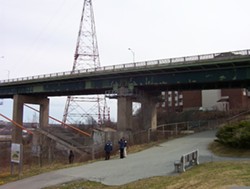
The pair drove together in Brian's truck, and parked in the Convoy Towers lot. They walked along North Ridge to the Seaview Lookoff path, and down the path to a park bench just past the bridge. The bench overlooks fenced land where Holly was found.
"We sat right here," says Brian, sitting on the bench. "And I said to him, 'Paul, I've been in this business a long time, and I definitely know I'll get to the bottom of what occurred, one way or the other.' I said, 'I know one thing for certain: there's something playing on your mind, that is really bugging you. It's plain and obvious as can be. I'm going to find out anyway...' And he sat there, and he stared in there and I let him think. I said, 'If I lost a child in there, I tell you, I wouldn't rest until I learned what was going on. I have no intentions of doing anything different for Marion.'
"And he sat there," continues Brian, "and he said, 'You're right. I did something I'm not very proud of. I stole from her.' I said, 'You stole from her?' He said, 'She handed me a wad of bills that night, over my shoulder, three 20s and three fives.' He gave her back, I think it was $1.50."
Fraser's new version of events was that when he dropped Holly off he purposefully gave her the wrong change. As he drove away, he told Brian, through his rearview mirror he saw Holly walking across the parking lot, away from the condo building entrance, and saw her trip over the curb on the opposite side. Almost immediately Fraser "felt bad" about cheating her, so he turned around on Kencrest Avenue, where he waited for the bus to pass, and drove back to the Convoy Towers parking lot. He got out of his car to search for Holly where he had seen her fall, but when he couldn't find her, he drove away.
The Coast recently called Fraser to give him the opportunity to explain his side of the story. "I do not want to respond," he said, and hung up the phone. Brian says Fraser told him he had given $60 to charity "to make up for what he had done."
Halifax Regional Police will not allow The Coast to speak with the officers who investigated Holly's death. But police chief Jean-Michel Blais says after being contacted by the Justice For Holly group, he was briefed on the investigation, and went to the MacKay Bridge site himself. "I've gone through the investigation," he says. "I'm satisfied that a proper job was done, and it's our hope the family can have closure."
Blais says the police spoke with Fraser after his conversation with Brian Parsons, and Fraser told them the story he'd told Brian, including that he had cheated Holly. "He didn't want to admit to taking money from a blind person," says Blais.
Fraser's new version of events was tested with a polygraph test which, say police, he "passed." Members of the Justice For Holly group say police told them the test consisted of Fraser providing a written version of events, including having taken money from Holly, and then being asked if that written version was correct.
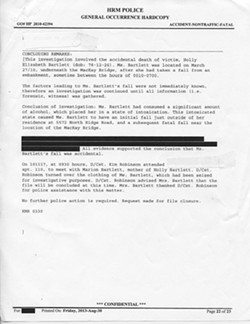
On November 17, 2010, Robinson wrote the concluding report for the file. "Ms. Bartlett had consumed a significant amount of alcohol, which placed her in a state of intoxication," wrote Robinson. "This intoxicated state caused Ms. Bartlett to have an initial fall just outside of her residence at 5572 North Ridge Road, and a subsequent fatal fall near the location of the MacKay Bridge."
The "initial fall just outside her residence" comes from Fraser's changed story—it wasn't part of McKinley's first theories about what happened. Fraser taking money from Holly isn't mentioned in the report, although the next three lines are redacted in the copy The Coast has reviewed. Next is written: "All evidence supported the conclusion that Ms. Bartlett's fall was accidental."
The police theory of what happened to Holly didn't change substantially from the first report, written the day Holly was found, nearly eight months before. It's the theory chief Blais uses when he talks about the case today. Extrapolating back from the .09 percent blood alcohol level Holly had Saturday morning, he estimates that at time Holly was dropped off Friday night, she had a blood alcohol level of around 0.2 percent.
"For a 95-pound person, that's a lot of alcohol," Blais says. "That in and of itself would be enough to kind of explain all of the movement. It's incredible she makes it, she walks down this concrete path and hits, basically, a door, goes to her left, down a hill to the fence, where she stopped, walks back along the fence, turns, and there's an opening in the fence and manages somehow to get onto the concrete."
The case is closed, but that doesn't give closure to the people who knew Holly. At one point during the investigation, Holly's mom spoke with detective Robinson about the unsettling lack of facts in the seven hours between Holly leaving Dalhousie in a cab and her being found by the abutment.
Robinson had a suggestion: "Maybe you should go see a psychic."
From the police investigators' perspective, the polygraph test had exonerated Fraser from responsibility for Holly's death. But at the same time, it seemed to Holly's sister Amanda that the polygraph provided conclusive proof that Fraser had stolen money from a fare.
Amanda took that knowledge to Brian Herman, owner of Casino Taxi, and to representatives of the Taxi and Limousine Commission, but got no results. "They just all pointed in different directions," says Amanda.
Herman acknowledges that he heard Fraser had stolen money from Holly. "We interviewed him, and he denied everything," says Herman. "With this one, you know, the driver in question has been a driver with us for, I don't know, 25, 30 years, and I don't think I've had a single complaint, not a driving infraction, or a customer service issue—nothing. To make a decision to affect someone's livelihood is a very serious thing. We couldn't really do a whole heck of a lot without a conviction and without any further information from the police."
While police chief Blais acknowledges Fraser admitted to taking money from Holly, he says "that evidence in that context could not be used against him in a court of law." This suggests that when police called Fraser in to ask him about the theft, and to take the polygraph test, they did not read him his rights. Had they done so, any statements he made about the theft could be used against him, but without the rights being read to him, his admission wouldn't stand up in court.
Fraser continues to drive for Casino Taxi, and is fully licensed by the city.
The missing seven hours before Holly was found are frustrating for her family and friends, and the Justice For Holly group meets regularly, hoping to find answers. A continued theme of their meetings is what they consider a weak police investigation.
As they see it, police had essentially wrapped up their investigation on Saturday, when Holly was in the hospital and McKinley first wrote his theory of her wandering the 300 metres from the condo driveway to the top of the abutment. That theory didn't change much even as new facts were uncovered—facts the police needed help to get.
The police hadn't found Holly's cane, but a group of Holly's friends did. And it was Brian Parsons who moved the investigation along: It was Brian, not the police, who thought to look for the bus video, and Brian who prodded detective Robinson to watch the whole video, not just the beginning of it. And it was Brian, not the police, who got Paul Fraser to admit to stealing money from Holly.
There's no indication that police took fingerprints from Holly's cane or any of the items found in the parking lot, including her phone and wallet. Also, Justice For Holly insists that police only canvassed for witnesses in the Kencrest apartment—the building overlooking the site under the bridge where Holly was found—after Brian urged them to. Police say they also canvassed Convoy Towers, where Holly lived, but Justice For Holly members say they've done their own canvassing of the building and found no one who spoke with police.
Moreover, the Justice For Holly group rankles at what they consider insensitivity from the police. McKinley behaved flippantly towards her mother, says Amanda, and at one point McKinley told Marion she had been "watching too much CSI." The group says police show continued distrust of Brian, perhaps because he's a civilian, even though, whatever his credentials, Brian discovered relevant information. And then there's Robinson's suggestion that Marion see a psychic.
Marion has had a particularly difficult time. She unexpectedly lost her daughter, and then, just 10 weeks later, her husband lost his battle with lung cancer. As Justice For Holly collected more information that had apparently been missed by police, Marion became increasingly frustrated.
With the help of a lawyer, this past summer, on July 15, Marion filed a Freedom of Information request with the police department. She asked for the investigative file on Holly, and essentially everything connected to the case: investigators' notes, transcripts of interviews, the bus video, the polygraph test, toxicology results and more.
As Marion is Holly's next of kin, she felt legally entitled to all the information she requested. On September 10, the police department sent Marion a handful of police occurrence reports—the notes officers place into the record after they are dispatched to a scene—and McKinley's supervisor's notes, but nothing else.
All of rest of the information requested was denied, explained deputy chief of police Bill Moore, who cited a section of the Freedom of Information Act that allows the withholding of information that "would be an unreasonable invasion of a third party's personal privacy."
Marion's lawyer has filed an appeal with the Freedom of Information and Protection of Privacy Review Office, but that office is backed up. The appeal won't even be looked at for the next two years.
"When something like this happens to you, you trust the people in authority," says Marion. "I had 110 percent confidence in the police department. I had 100 percent confidence that the taxi driver would do what he was supposed to do. I was just, you know, a little cashier manager from Shoppers Drug Mart. And my husband was a carpenter. And we just went along and minded our own business and nothing bad ever happened to us. Right?"



